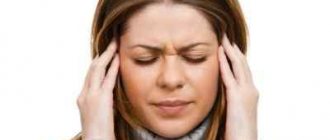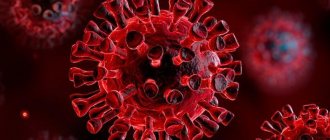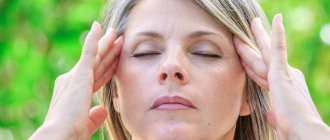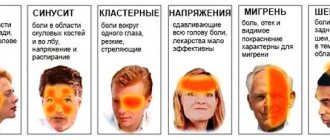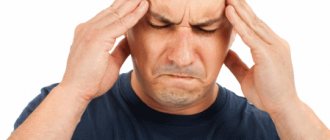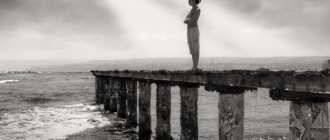A head contusion differs from all other types of traumatic brain injuries in that there is no damage (tear) to the skin. Usually occurs from a blow with a blunt object, during an accident or after a fall.
There are 2 main types of injury:
- Brain contusion (this is what the article pays close attention to).
- Contusion of the soft tissues of the head (least dangerous).
The risk of developing one or another type of head injury depends on the intensity of the traumatic factor. The stronger it is, the deeper layers are affected.
In this case, a brain contusion is often combined with hemorrhage both into the brain tissue and under its arachnoid membrane, which aggravates the person’s condition. Often such patients are diagnosed with skull fractures.
Main symptoms of head injury
The symptoms of a head injury fit into 3 main syndromes:
- General cerebral
, associated with a nonspecific brain reaction to injury. - Local
, depending on the immediate location of the brain injury (the most dangerous are injuries affecting the medulla oblongata, since it contains the centers for regulating breathing and cardiac activity). - Meningeal
, caused by irritation of the meninges.
General cerebral symptoms occur with a bruise of any severity. Their presence and connection with the traumatic factor allow the doctor to make a preliminary diagnosis.
These symptoms include:
- diffuse pain in the head;
- nausea causing vomiting;
- dizziness;
- decreased attention;
- weakening of memory up to its loss for some events.
The appearance of meningeal symptoms indicates severe brain damage. Prognostically, this syndrome is not very favorable.
It is indicated by:
- Strong headache;
- tension in the muscles of the neck and back;
- repeated vomiting, after which there is no relief, etc.
Local (focal) symptoms allow for topical diagnosis, i.e. guess in which lobe of the brain the pathological focus is located.
Thus, when the back of the head is bruised, visual functions are affected. This is due to the fact that the peripheral nerve pathway from the eyeballs ends in the occipital lobe and switches to the central one.
Therefore, a person may experience temporary blindness, double vision and other ophthalmological signs.
They should be differentiated from similar symptoms, but associated with direct injury to the eye, which leads to retinal detachment. A patient with a contusion of the back of the head requires additional consultation with an ophthalmologist.
Focal symptoms of contusion of the frontal lobes also have a characteristic picture:
- the unconscious state is replaced by mental and motor excitement;
- confusion;
- aggression;
- euphoria and incorrect assessment of one’s condition;
- reduction of criticism, etc.
Head contusions are conventionally classified into 3 degrees, determining the severity of a person’s condition and its further prognosis.
Light damage
characterized by the following criteria:
- Loss of consciousness lasting no more than a few minutes;
- Its rapid restoration without auxiliary methods;
- General cerebral symptoms prevail over focal ones;
- Involuntary movements made by the eyeballs;
- Sometimes sensitivity and motor activity may decrease on the opposite side of the body relative to the side of the brain injury (this symptom is more typical for a moderate injury, but can also occur with a mild injury);
- Regression of clinical symptoms and morphological changes takes 2-3 weeks. Almost no residual changes are observed.
Moderate bruise
brain is accompanied by a pronounced disturbance of the general condition.
Its signs are:
- Longer loss of consciousness – up to 2-4 hours;
- Consciousness is stunned for several hours, up to a maximum of 24 hours;
- General cerebral symptoms are moderately expressed;
- There are manifestations of meningeal syndrome;
- Focal symptoms are loss of speech, perverted sensitivity, inability to move the limbs of the right or left side normally, increased breathing, and others.
(severe) poses a serious threat to life.
It may be accompanied by a coma that persists for several days. These patients have disturbances in the functioning of the respiratory and cardiovascular systems, which require medication and hardware correction. Otherwise, death occurs.
Other signs of a severe injury include:
- Loss of memory for events that preceded the injury;
- Visual impairment;
- Motor restlessness;
- Increased mental excitability, etc.
A bruise of the soft tissues of the head, which is not accompanied by brain damage, does not pose a serious danger to humans.
This is a fairly common condition that can be caused by a blow to the head with a blunt object, without breaking the integrity of the skin. It most often occurs in athletes, but can also occur in everyday life.
A lump on the head with such a bruise is the leading symptom. She appears in the place where the blow was struck. When it is felt, it is painful. There may be minor abrasions on the skin, but there is no epithelial defect as such.
Cones are the result of 2 mutually determining processes:
- Hemorrhages in tissue due to mechanical rupture of blood vessels;
- Swelling due to the release of plasma into surrounding tissues.
Usually, no specific treatment is required for a head injury. Immediately after an injury, it is recommended to apply ice to the injured area. This will lead to vasospasm and reduce hemorrhage.
Subsequently, warming physiotherapeutic procedures (UHF, electrophoresis) are recommended to accelerate resorption. If the head hematoma after a bruise is massive, then surgical treatment may be required, consisting of two stages:
- Opening the hematoma (an incision is made on the skin under anesthesia);
- Treatment of the hemorrhage cavity and drainage (introduction of special tubes through which the contents will flow out and, if necessary, the introduction of antiseptics).
In some cases, soft tissue hematomas can fester (and this does not depend on their size). The risk of developing this complication increases in patients with diabetes.
When hemorrhage suppurates, it is opened and antibacterial therapy is prescribed. This approach will prevent the transition of purulent inflammation of soft tissues to the brain.
First aid at home and when to go to hospital
First aid for a head injury - its quality and timeliness - determine the effectiveness of further treatment. Therefore, you need to know how to provide it correctly.
The priority activities are:
- Turn the injured person's head to the side to prevent possible vomit from entering the respiratory tract;
- Removal of all removable dentures and removal of foreign bodies from the mouth;
- If consciousness is preserved, then the person must lie down - standing or sitting is prohibited;
- Fixation of the cervical spine using any means that are at hand.
In parallel with providing first aid, it is necessary to call an ambulance.
It should be remembered that if you receive any head injury, you should always consult a doctor, because... In some patients, bruises may occur with minimal symptoms at the beginning, but then lead to serious consequences.
Diagnosis and treatment
Diagnosis of patients with suspected head contusion is carried out comprehensively:
- X-ray (to exclude fractures and identify local lesions in the brain);
- Spinal puncture (increased number of red blood cells is determined);
- Computed tomography (with its help you can identify not only the site of the injury, but also the therapeutic reserve zone - edema and ischemia).
The Glasgow scale helps determine the degree of consciousness impairment. Depending on the score, therapeutic measures and further prognosis are planned.
The principles of treatment for brain contusion are determined by the nature and stage of pathological changes. Depending on this, primary and secondary damage to nervous tissue is distinguished.
Primary
– these are those that are directly caused by the impact of a traumatic factor. These injuries are represented by a variety of conditions:
- Violation of the structure of nerve cells and glia (surrounding nervous tissue);
- Breaks in connections between nerve cells;
- Vascular thrombosis;
- Rupture of the vessel wall;
- Increased permeability of cell membranes and energy starvation (the number of ATP molecules decreases), accompanied by cell death.
There is a zone of increased sensitivity around the immediate pathological focus. These are living nerve cells, but easily vulnerable when exposed to any pathological factor (lack of glucose or oxygen).
It is this zone that represents the therapeutic reserve, i.e. with proper treatment, these cells will replace the dead ones, and there will be no loss of the function for which the bruised lesion was responsible.
Secondary
damage develops as a result of the inflammatory process, which is always present during injury. Depending on the intensity of inflammation, nerve tissue cells can be either restored or damaged. Treatment should be aimed at creating conditions for recovery.
Treatment of a head contusion can be conservative or surgical.
The latter type of assistance is required in 10-15% of cases for patients diagnosed with brain contusion.
Indications for surgical treatment are:
- Hematoma, the internal diameter of which exceeds 4 cm;
- Significant displacement (more than 5 mm) of brain structures, with the exception of the hemispheres;
- Severe intracranial hypertension, which cannot be eliminated by pharmacological methods.
Conservative treatment includes:
- Diuretics to reduce the severity of cerebral edema;
- Oxygen therapy (if necessary, tracheal intubation is performed);
- Infusion therapy and maintaining blood pressure at an adequate level;
- Anticonvulsants;
- Antihypoxants that reduce the severity of ischemic changes, increase the resistance of nervous tissue to oxygen starvation and promote its recovery.
Consequences of a bruise
The consequences of a head injury are varied and depend on the severity of the condition. In mild cases, symptoms usually quickly regress without leaving a trace. With severe bruises, there is a high probability of certain complications:
- Apallic syndrome - a person is conscious, but indifferent to his surroundings, unable to fixate objects and people, reacts only to painful stimuli (state of waking coma);
- Paresis – loss of the ability to move muscles;
- Brain cysts;
- Abscess is the formation of a purulent cavity in the brain;
- Persistent intracranial hypertension;
- Chronic headache is a condition where the head hurts after a bruise for 6 months or more;
- Meningitis is an inflammatory lesion of the meninges;
- Secondary epilepsy.
With a severe injury, there is a high risk of death or disability.
The success of treatment will depend on the timeliness of seeking help and the severity of the lesion.
Bed rest
Does a person feel sick after hitting their head? Most likely he has a concussion. The next point of action is compliance. That is, immediately after the blow it is necessary to transfer the “victim” to a horizontal position. But in such a way that after regaining consciousness the person feels comfortable and comfortable.
By the way, for concussions, the absence of brain tension, as well as bed rest, are the main methods of treatment. Therefore, try to provide the person with peace for a while. Just don’t leave the victim alone - maybe he will need your help!
FAQ
- Can you feel dizzy after a head injury?
Depending on the severity of the bruise and its massiveness, dizziness may persist for several months. If it is very intense, the doctor may prescribe specific medications that will help eliminate this unpleasant symptom.
Over time, with a slight injury, dizziness goes away on its own.
- What to do if you bruise the back of your head?
In this case, immediately after injury you must:
- apply ice or a towel soaked in cold water to the injured area;
- take a horizontal position and turn your head to the side;
- call an ambulance or go to the hospital yourself (when transporting in a car, it is recommended to lower the seat as much as possible).
According to statistics, up to 70-80% of head injuries are completed. This pathology is characterized by severe neurological problems, and one of its common symptoms is headache. Do you always get a headache after hitting your head? What could this indicate? And how to treat a concussion?
Head injuries have serious health consequences. They can cause a concussion, bruise, vascular rupture or interstitial hematoma. Even minor damage can lead to further problems: why you get a headache after hitting your head, what consequences this can lead to, and how to avoid complications: read more in our review.
In children
Hitting your head doesn't have the best consequences. People often experience concussions after such an injury. A fairly common occurrence, with minor head trauma it does not cause much harm. Only serious damage can negatively affect the development of the body. Especially for children.
It has already been said that a concussion will manifest itself differently at different ages. You will have to closely monitor your child if he hits his head. Newborns usually turn pale and their heart rate increases. But after this, lethargy, fatigue, drowsiness suddenly sets in, and sleep is disturbed. During feeding, numerous regurgitations are possible, the child behaves restlessly, and may cry for no reason for a long time. This injury is difficult to detect in newborns.
But older children can already tell something about their condition. Does your head hurt after hitting your head? In principle, the manifestations of injury are similar to those observed in infants. But only sometimes a child can get short-term amnesia. This is normal and indicates a concussion.
Causes of pain during injury
Pain is the body's natural response to injury. In addition to headaches, the victim may experience weakness, fatigue, nausea, vomiting, memory impairment and dizziness. In severe cases, loss of consciousness and coma develop. These symptoms are a sign of compression of the brain matter and damage to nerve cells. The nature of the sensations and possible consequences depend on the type of injury. Pain may be caused by:
- falling;
- blow to the head with a sharp or blunt object;
- head injury at work or during an accident.
If a person experiences a headache after a blow, it is important to immediately consult a doctor for an examination and a full diagnostic examination.
Start
Signs of a concussion can vary. They, as practice shows, differ depending on the age of the victim. Therefore, it is worth understanding: a child, an adult and an old person have different signs.
The first step is to understand how grass manifests itself in an ordinary middle-aged person. The first time after the impact plays a huge role. Typically, during this period, one-time vomiting, clouding of mind (with short-term amnesia), and rapid breathing are possible. Also, after a blow to the head, the victim has a headache with any movement, the pulse quickens or slows down. These manifestations disappear very quickly; they can accompany a person for half an hour. It all depends on the degree of injury.
Signs of a concussion
Head injuries and pain are very common. Unfortunately, patients are not always provided with assistance and undergo timely examination. There is an explanation for this:
- high risk of injury both at work and at home;
- the appearance of neurological symptoms 36-48 hours later, and not immediately after the incident;
- the difficulty of identifying the problem, which consists in the paucity of clinical symptoms, underestimation by victims of their condition, and insufficient qualifications of first-line medical workers.
Note! In a quarter of cases, a concussion causes chronic, causeless headaches that do not respond well to traditional treatment with painkillers.
Any traumatic brain injury can lead to a concussion. Common symptoms of this pathology are:
- Loss of consciousness (usually short-term, up to 2-3 minutes). The longer the period, the more severe the concussion.
- – often the victim, after regaining consciousness, cannot name the circumstances of the injury. Retrograde amnesia is associated with severe disturbances in active brain activity at the time of impact.
- Sharp weakness.
- Noise in ears.
- If a woman (or man) complains that she hit her head and now the back of her head hurts, this is often another manifestation of a concussion. In this case, the pain is acute, often unbearable, pulsating.
- Dizziness.
- Pain when moving the eyeballs.
- The appearance of symmetrical hemorrhage under the eyes (“spectacles symptom”) is a characteristic symptom of a concussion, appearing 2-8 hours after the injury.
- Nausea, vomiting.
- Sweating.
- Increased or vice versa, slowing of heartbeat.
- A rush of blood to the face and skull, which the victim feels as heat and tingling.
- Sleep disorders.
All these symptoms can develop gradually over 2-3 days. Therefore, if a patient who hit her head does not complain that she has a headache during the initial examination, but after 1-2 years her condition sharply worsens, this may be due to the peculiarities of the course of the disease.
In adults
The first signs of a concussion are clear. But, as practice shows, defining injury in this way is very problematic. Typically, diagnosis is based on a description of a citizen’s complaints. What can be observed some time after receiving a concussion?
There are many options for the development of events. In any case, with serious injuries, you will experience nausea and even vomiting. We are talking about repeated incidents. General weakness of the body, sleep disturbances (usually in the form of insomnia), pressure surges - all this also indicates a concussion.
Does your head hurt for a long time after hitting your head? Something like migraines has started? Is the temperature fluctuating? Does your face turn red for no reason? Then it's time to go to the doctor. You most likely have a concussion. It is noted that in adults, trauma is often manifested by memory loss (amnesia), sweating and tinnitus. It is possible that you will simply feel uncomfortable. Pay special attention to these signs.
Principles of treatment
If the victim has a headache after a blow: what to do in this case? Follow the doctors' recommendations:
- Provide emergency assistance to the victim. If he is conscious, place him on a hard, flat surface, raising his head and shoulders slightly higher than his pelvis and legs. If a person is stunned and does not respond to speech addressed to him or other stimuli, place him on his right side, slightly tilting his head back and turning his face down. In this case, the left limbs should be bent at an angle of 90 ° and lie freely on the ground. This position will provide the victim with easier access to fresh air into the respiratory tract, and will not allow him to choke on gastric contents in case of possible vomiting.
- Call an ambulance or take the victim yourself to the emergency room for a primary medical examination.
After examination and assessment of the severity of the condition, the patient can be sent home with recommendations or left in the neurological department of the hospital for treatment. All victims with a concussion are prescribed strict bed rest, more sleep and rest. The patient is prohibited from watching TV shows and films, listening to the radio, music, and even reading for 10-14 days, as this can lead to irritation of the central nervous system. Depending on the symptoms of the disease, the doctor prescribes:
- painkillers (Ketorolac, Pentalgin);
- sedatives (Phenobarbital, Finlipsin);
- light sleeping pills (based on chamomile, mint, motherwort);
- drugs for dilating cerebral vessels and preventing cerebral edema (Sermion, Cavinton, Eufillin);
- antioxidant therapy (Glycine, Mexidol).
Within a year after the injury, the patient is registered with a neurologist. During this period, the specialist can assess the dynamics of the treatment and determine the delayed consequences of the concussion. If after hitting your head the neck hurts for a long time, and the patient is bothered by periodic headaches, the doctor prescribes additional examination (CT, MRI) to accurately determine the cause of the pain.
Unfortunately, none of us are immune from injury. It can overtake us both at work and during a regular walk in the park. Accidents haunt us all our lives, and even in those moments that, well, in no way promise trouble, we can stumble and fall, hitting our heads. Naturally, after hitting your head, discomfort and pain appear in it, and this is quite normal. But under no circumstances should you let the problem take its course, especially if the symptoms only get worse.
When to see a doctor
After a blow to the jaw, nose or any other area of the head, it is very important to monitor the nature of the pain. What kind of pain is this? How strong is she? Is it constant or pulsating, etc. You may start to worry when:
After hitting your head, the pain persists for several days; You cannot cope with painful sensations with pills; The pain pulsates and clearly radiates to the temple, or causes tinnitus; The neck becomes stiff, movements are difficult; Speech is impaired, the sense of balance is lost; It is difficult for you to concentrate on one thing or focus your vision; Any rustle causes a painful response in the head, the light is very unpleasant for you, etc.
In addition, you should consult a doctor if you have even the slightest suspicion of a concussion, which may be indicated by the following symptoms:
Dizziness; nausea; loss of consciousness; bruises under the eyes; very severe weakness; vomiting, etc.
A concussion is a serious matter and can occur from a blow to the nose or from being hit by a ball on the soccer field. That is, sometimes it doesn’t even take a particularly strong blow to get injured.
When a concussion occurs, a person may regularly lose consciousness, experience hallucinations, and have convulsions. If this occurs after a blow to the temple, then it is better to call an ambulance instead of taking the victim to the hospital or going there yourself.
How can they help in the hospital?
In the hospital, the doctor will be able to take an X-ray of the head, study the problem in detail, and then develop the most effective course of treatment. This can be either hospitalization or bed rest with an individual course of medication. The main task of the doctor will be:
Improve metabolism between brain cells; Strengthen the walls of blood vessels; Prevent swelling in the brain area; Restore blood circulation; Relieve painful sensations.
Unlike self-treatment, here the causes of the pain themselves will be removed, and not its symptoms.
How to provide first aid?
If you see that a person is lying on the ground after being punched, or that he has simply fallen and does not get up, then until the ambulance arrives, you must immediately provide him with first aid. To do this, do the following:
Turn the person onto their side to prevent them from choking on vomit; Make sure that the victim remains motionless. Don't let the person move their neck; After a blow to the jaw, carefully fix it, but do not press down; If there is damage in the temporal region, then apply something cold to it. Do this delicately, without pressure.
Such a set of measures will mitigate the consequences of the blow, and sometimes even save a person’s life. Never pass by such situations. Today you helped, tomorrow they will help you.
Treatment with medications
Today, many painkillers are sold only by prescription, so if you do not want to see a doctor, you will have to choose from what is available. Among the commonly available headache-relieving pills, you can try:
Nurofen; analgin; paracetamol; Unispasm; spasmalgon; migrenol, etc.
However, you shouldn’t overuse pills either, and if after a few days of treatment you still have a headache after a blow, you know what to do. Throw aside all fears, overcome laziness and finally visit a doctor. After all, a headache is no joke, and in order to avoid worsening the situation, you should definitely consult a specialist.
Relieving headaches at home
Headaches often occur even after the most minor injury. In such cases, regular mint tea with honey and a good healthy sleep may be enough. After a few hours of rest, the pain may completely leave you. It wouldn’t hurt to apply a fresh cabbage leaf or a damp scarf to your head. After hitting the back of your head, place a compress under your head. If the blow hits another area of the skull, then lean the compress against the damaged area and wrap your head with something soft.
In addition, a relaxing hot bath with the addition of lavender, eucalyptus, rose or any other essential oil helps very well. Aromatherapy can be done without a bath. To do this, prepare a bowl of hot water and add a few drops of oil to it, then place it near the head of your head.
Traditional methods
Among the folk methods of getting rid of headaches, one can note all kinds of vegetable and herbal decoctions. The following drinks, taken on an empty stomach, are especially helpful:
Decoction of potatoes with the addition of a small amount of salt; Tomato juice with garlic; Beetroot and carrot juice; A drink consisting of broccoli, sorrel, parsley and one raw egg, beaten in a blender.
These cocktails have a calming effect, help lower blood pressure and relieve pain in the affected area of the head. For acute and throbbing pain, which usually occurs after a blow to the temple, traditional medicine recommends taking herbal tinctures based on:
St. John's wort; elderberries; clover; mint.
For hundreds of years, people have saved themselves from headaches using these very methods, and it is quite possible that they will help you too. If you don’t trust traditional medicine too much, then you can immediately move on to drug treatment.
Afterword
Children are often hit on the head. They lead the most active lifestyle, constantly jumping, getting mad and playing around, risking injury at any moment. Therefore, if, for example, even a stranger on the street comes up to you and says that she hit her head and now it hurts, do not ignore it. Contact the child's parents immediately and explain the seriousness of the situation. The child’s body, although it recovers quickly, is very susceptible to injury. These can even occur after hitting your forehead against the forehead of another child. Finally, we recommend watching Dr. Komarovsky’s recommendations in the video below.
Be careful and observant, and, most importantly, never get too carried away with self-medication - the help of a qualified doctor is never superfluous!
Head injuries are very dangerous for humans, as they can be fatal. It is not without reason that safety standards are provided for people in enterprises, when playing sports, and during some types of outdoor activities, according to which it is necessary to use a protective helmet or helmet. Despite the fact that the human skull strongly protects the brain from damage, any blow to the head is very dangerous. If you have a headache after an injury, this is a serious reason to consult a doctor.
Head injuries after an impact can be open or closed. In case of an open injury, it is not difficult for a specialist to qualify the injury, apply first aid and prescribe treatment. As for closed head injury, its danger lies in the absence of external signs. The diagnosis is made on the basis of indications about the well-being of the patient himself and after conducting numerous studies and wasting precious time.
After receiving a blow, a head injury, or after a fall and the absence of external symptoms of injury, a person, due to his carelessness, in most cases, refuses to immediately consult a doctor, although many closed head injuries require hospital treatment. Moreover, the force of the blow is not always proportional to the pain. The most severe injury may cause mild pain.
Headaches that occur after hitting your head may be accompanied by side effects of the injury.
What to do next?
The victim must be handled as carefully as possible - do not move him abruptly, cover him from the sun's rays, and allow him to get enough sleep. After you have the opportunity to get to the hospital, a consultation with a doctor is required.
You should not avoid visiting the hospital - refusal of treatment and careless attitude towards your health will not contribute to recovery, and the consequences of a blow to the head can bring a lot of complications.
Without proper treatment, patients may further suffer from migraines, weather dependence, and fatigue.
If an injury occurs, even if first aid was provided correctly, doctors recommend calling an ambulance and taking the patient to the nearest medical facility, where it is possible to do a CT scan of the brain. Only with the help of this type of diagnosis can we clearly answer what the brain damage is and how serious it is. Typically, doctors refer urgent patients to the neurosurgery department or traumatology department.
If it is not possible to use this type of help, at least an X-ray of the skull, an examination by an ophthalmologist and an echoencephalography are necessary, which will help confirm or refute the presence of intracranial hemorrhage. In order to establish a clear localization of the hematoma, you need to contact a specialized medical institution. Usually a referral is given there from the clinic where the patient was taken.
If your head starts to hurt after a blow, it is important to consult a doctor, as such a symptom may indicate a concussion, vascular rupture, or internal hematoma. The first step is to check how the victim reacts to the environment around him. Headaches after injury are dangerous for a person because they can cause death. For this reason, people who work in production or who build houses must wear hard hats. What to do if an injury occurs and a person suffers from a headache?
Your head may start to hurt due to various situations. For example:
- The man fell and hit his head;
- A hard and heavy object or stone was thrown at the head by another person;
- If the victim was hit on the head with a bat;
- A person suffered a head injury due to a traffic accident;
- Injury caused during a fight between several people;
- If the victim was deliberately beaten.
If a person is hit in the head, a large hematoma may occur. In severe cases, severe bleeding may occur, especially if the blow occurs in the forehead area. Often falling and injuring the head leads to a concussion. Because of this, the victim may lose consciousness and memory. A concussion can lead to mental problems.
Consequences of head impacts that cause pain
A common consequence of head injury is headache and temporary brain dysfunction. In most cases, after a concussion, the body quickly recovers, but often the initial signs of a concussion mask the accompanying consequences of the injury.
Head injuries can cause vascular malformations of the brain vessels. - This is an abnormal connection of arteries or veins and their interweaving. These formations cause not only pain, but can also be the cause of paralysis of the limbs and. In this case, pain occurs in the area of malformation formation. This problem can be successfully treated surgically.
Internal hematoma
may occur after a strong blow to the head. occurs in the area of rupture of a blood vessel in the brain tissue itself or between the brain and the skull. Even a small hematoma can put pressure on the brain, thereby interfering with its activity. With an internal hematoma of the head, there may be no external signs in the form of bruises or abrasions at all. Hematoma is treated with laser or surgery.
Cerebral aneurysm (
abnormal bulging of areas of brain vessels filled with blood) occurs when a strong blow to the head occurs. The bulging areas put pressure on the brain and nerve centers, causing brain dysfunction, but the greatest danger is rupture of the aneurysm, which is often the cause of death.
Traumatic brain injury can provoke inflammation and accumulation of cerebrospinal fluid
- a fluid that fills the space between the brain and skull.
This disease is called hydrocephalus. Very rarely, a blow to the head can cause pneumocephalus
- the accumulation of air inside the skull. Both diseases are treated with surgery.
Rupture of the eardrum
Due to a blow to the head, it is accompanied by pain and can even cause bleeding from the ear. The main danger with such an injury is infection in the inner ear. Hearing loss can be temporary, but the eardrum has the property of regeneration and is usually completely restored without medical intervention in 2-3 weeks.
A blow to the head may cause swelling of the brain
– an increase in brain volume due to the accumulation of excess fluid in the brain cells. Cerebral edema develops very quickly and requires emergency care. Treatment is based on restoring normal blood circulation, while the blood is artificially enriched with oxygen.
The cause of headaches may be displacement of the cervical vertebrae
, which can be caused by a fall or a blow to the back of the head. In this case, the cause of headaches is impaired blood circulation. A chiropractor and therapeutic exercises will help eliminate this problem.
Practice shows that after hitting your head, pain can periodically return for decades. To prevent pain from becoming a habit, and also to prevent the development of any brain abnormality, do not hesitate to visit your doctor. Specialists can identify the cause of the headache and, depending on the nature of the injury, prescribe treatment.
Classification
The injury can be open, that is, damage to the skin is observed, and blood vessels are also affected. If the injury is penetrating, then the dura mater of the brain is affected, sometimes a fracture of the base of the skull is diagnosed - one of the most dangerous injuries.
With closed injuries, the skin is not injured. The following groups of brain damage have been identified:
- A concussion is a mild degree of traumatic brain injury, the manifestations of which disappear after a few days, there are no symptoms of vascular damage, and functional disorders are reversible. A bruise is a more severe injury and may cause brain damage. Manifested by such symptoms as nausea, vomiting, pale skin, tissue swelling, pain.
- compression of the affected area of the brain (foreign object, hematoma, air, bone fragment);
- hemorrhage in the subarachnoid space (the cavity between the arachnoid and pia mater);
- diffuse damage.
A severe brain contusion can result from a combined injury.
With a head injury, there are 2 types of bruises:
- Brain contusion.
- Contusion of the soft tissues of the head.
Sometimes the injury is accompanied by hemorrhage. This is often accompanied by fractures of the bone tissue of the skull.
Types of damage are identified depending on location:
- contusion of the back of the head;
- damage to the temporal region;
- bruise of the frontal part of the head;
- damage to the parietal lobe.
Changes that occur in the brain as a result of a bruise are divided into primary and secondary. Primary ones are caused by the injury itself, and secondary ones are caused by deterioration of tissue nutrition and increased intracranial pressure, the appearance of edema, and hematomas.
In case of serious injuries, contusion of several areas of the brain is sometimes diagnosed.
When a child bruises the soft tissues of the head, a lump appears. However, as a result of the blow, brain injuries are also possible, the consequences of which can appear in adulthood, after 40 years or later. Therefore, even if a lump simply appears after a blow, it is recommended to seek medical help.
Specialists
- Therapist.
- Orthopedist-traumatologist.
- Otolaryngologist.
- Neurologist.
- Surgeon.
- Chiropractor.
A seemingly insignificant blow to the back of the head can actually turn out to be a serious injury and lead to unexpected consequences for the victim. In the brain structures of the occipital part, bundles of nerve fibers responsible for the functioning of the visual system are concentrated. Even a slight bruise to the back of the head, not to mention more significant and serious injuries to this part of the head, can lead to the development of visual disturbances or complete blindness, as well as the appearance over time of consequences associated with damage to the nervous system.
If you hit the back of your head, then in order to reduce the likelihood of complications, the person suffering from a head injury should definitely undergo diagnostics from specialized doctors and, if violations are detected, follow their further recommendations.
ethnoscience
After hitting your head, your neck hurts, you feel nauseous and other symptoms are observed, which means that rest and a complete lack of mental and physical stress are required. According to reviews from victims, several folk remedies help alleviate the condition during the rehabilitation period:
- improves metabolism in the brain ginkgo biloba leaf;
- collection of thyme and motherwort: decreases the excitability of the nervous system;
- a soothing decoction of hop cones, buckthorn bark, valerian root, lemon balm, fireweed, St. John's wort and birch leaves;
- honey and bee pollen normalize the process of feeding neurons;
There is no need to constantly drink decoctions and infusions, because brain tissue recovers relatively quickly after a concussion. Some people prefer to resort to homeopathy.
How long to treat, after what period therapy is stopped, is determined only by the doctor, even if we are talking about alternative medicine. It is important to realize that no infusions can completely replace tablets.
Consequences of hitting the back of your head
A contusion of the back of the head, like all traumatic brain injuries, in the absence of proper treatment and recovery period can lead to irreversible and serious consequences. An imaginary improvement in the first months and the absence of symptoms characteristic of a head injury often leads to the fact that the patient immediately after treatment returns to his usual lifestyle and at the same time ignores the doctor’s recommendations about a gentle regimen. The consequences of such actions begin to appear months or years after the injury to the back of the head in the form of the following signs:
- Visual disturbances in the form of unilateral spatial agnosia. The patient does not perceive part of the space from the side of the previous injury, as a result of which he cannot orient himself in the objects around him, for example, distinguish their correct location and the distance between them.
- Post-traumatic asthenia, manifested in the form of causeless changes in mood (from irritability to apathy), absent-mindedness, sleep disturbances, decreased performance, memory, concentration and mental activity.
- and headaches that occur due to bad weather, alcohol intake or nervous overexcitation.
- Susceptibility to depressive moods, unreasonable fears and anxieties.
- Mental confusion and hallucinations.
To reduce the risk of the described consequences, you should consult a doctor even if you hit the back of your head on a hard object. This recommendation especially applies to children whose basic vital systems and brain tissue are in the stage of growth and formation.
First aid for a bruised head
If a person hits the back of his head, then the nature of the actions that need to be performed in case of a back injury directly depends on the severity of the blow and the symptoms that appear in the first minutes.
If there is a slight blow to the back of the head, consciousness is present, and there is no nausea or signs of disorientation, the victim should be given the following assistance:
- put it on the sofa or bed;
- ensure silence;
- apply a cold compress in the form of ice wrapped in a towel to the back of the head every 15 minutes with a break of half an hour;
- treat an abrasion or hematoma if the skin is damaged as a result of the blow;
- Show the victim to a doctor to rule out a mild concussion.
Loss of consciousness even for a short period of time, nausea, dizziness and disorientation in space may indicate a more serious traumatic effect: or the formation of intracranial hematomas. In such cases, people with the injured person should promptly take the following actions:
- Carefully place the victim on a flat, hard surface. If there is a possibility of damage to the vertebrae of the neck or back, then moving it is not recommended. In this case, you should carefully turn the injured person on his side so that he does not choke on the mass in case of vomiting, and raise his head a little.
- Call a medical team immediately and do not let the victim fall asleep until they arrive.
- Measure the injured person’s pulse and ask him how he is feeling, so that he can then provide this information to the doctors.
If the symptoms are severe, the victim should not apply compresses to the injury site or give painkillers. A decrease in symptoms and dulling of sensations as a result of taking them can complicate the diagnosis of injury and lead to the prescription of incorrect treatment.
Cool
To prevent the formation of a hematoma after an impact, immediately after the injury it is necessary to apply ice to the site of the injury. A damp, cold towel also works.
In general, cool the injury site by any means. This approach will not only prevent the appearance of bumps and bruises, it will also help to cheer up and improve the general condition of the victim. Especially when it comes to minor injuries. If you suspect something serious, call a doctor or an ambulance immediately!
Treatment of trauma to the occipital part of the head
Treatment of occipital injury is prescribed by a specialized doctor (neurologist, traumatologist or neurosurgeon) after diagnosis and determination of the severity of the injury.
After a certain time, even if you feel well, you need to visit a doctor for a preventive examination. This will reduce the likelihood of complications and subsequent unpleasant sensations that interfere with living a full life.



